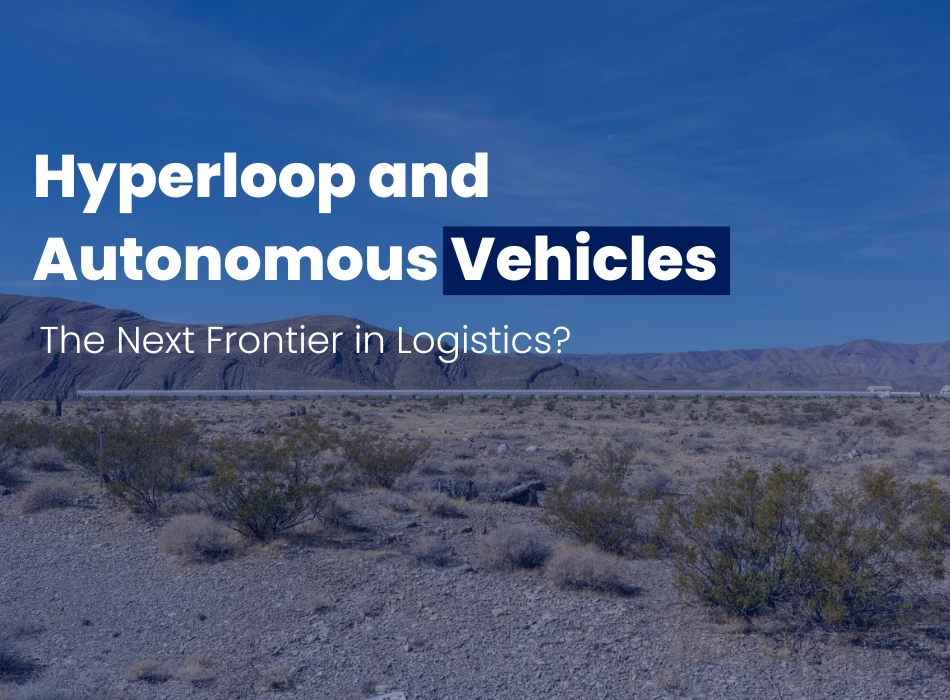Hyperloop and Autonomous Vehicles: The Next Frontier in Logistics?
Explore how Hyperloop technology and autonomous vehicles are shaping the future of logistics by enhancing speed, efficiency, and sustainability in freight transport.

The logistics industry is on the brink of a transformative shift with the advent of Hyperloop technology and autonomous vehicles. These innovations promise to enhance efficiency, reduce costs, and minimize environmental impact in the transportation of goods. As e-commerce continues to grow, the need for faster, more reliable logistics solutions is becoming increasingly critical.
This blog will explore how Hyperloop and autonomous vehicles are poised to reshape the future of logistics.
Understanding Hyperloop Technology
What is Hyperloop?
- Hyperloop is a revolutionary transportation system that utilizes pods traveling through low-pressure tubes at speeds exceeding 1,000 km/h (620 mph). This technology minimizes air resistance and ground friction, making it one of the fastest modes of transport available. Hyperloop aims to provide a sustainable solution for freight transport, significantly reducing emissions while improving delivery times.
Applications in Logistics
- Hyperloop systems can be integrated into existing logistics networks, allowing for rapid movement of goods between distribution centers and urban areas. For instance, HyperloopTT is developing a system called HyperPort, designed specifically for transporting ISO shipping containers efficiently between ports and inland logistics hubs.
The Role of Autonomous Vehicles
Enhancing Last-Mile Delivery
- Autonomous vehicles (AVs) are increasingly being deployed for last-mile delivery solutions. These vehicles can navigate urban environments without human intervention, reducing labor costs and improving delivery efficiency. Companies like Amazon are testing AVs for delivering packages directly to consumers’ doorsteps.
Integration with Hyperloop Systems
- The combination of AVs and Hyperloop technology creates a seamless transportation network. AVs can serve as first and last-mile solutions, transporting goods to and from Hyperloop stations. This integration optimizes logistics operations by providing efficient connectivity between different transport modes.
Benefits of Combining Hyperloop and Autonomous Vehicles
Speed and Efficiency
- Both technologies promise to drastically reduce transit times. Hyperloop can transport goods across long distances in a fraction of the time compared to traditional rail or road transport, while AVs can streamline local deliveries.
Environmental Sustainability
- Hyperloop systems are designed to be energy-efficient, potentially generating more energy than they consume through renewable sources like solar panels installed along the transit line. Coupled with electric autonomous vehicles, this creates a highly sustainable logistics ecosystem.
Reduced Congestion
- By shifting freight transport from roads to Hyperloop systems, cities can alleviate traffic congestion, leading to improved air quality and reduced travel times for both goods and passengers.
Real-World Case Studies
- Virgin Hyperloop
Virgin Hyperloop has conducted successful test runs demonstrating the feasibility of using hyperloop technology for freight transport. Their system aims to connect major urban centers quickly, reducing delivery times significantly compared to traditional methods. - Zeleros HyperPort Project
Zeleros is developing a hyperloop system specifically for freight transport called HyperPort, which targets the efficient movement of containers between ports and inland logistics facilities. This project aims to enhance port capacity while minimizing environmental impact. - Waymo’s Autonomous Delivery Services
Waymo has been piloting autonomous delivery services in select cities, focusing on last-mile logistics for e-commerce companies. Their self-driving vehicles have demonstrated the ability to navigate complex urban environments safely, providing valuable data on operational efficiency.
Challenges Ahead
While the potential benefits are significant, several challenges must be addressed:
- Regulatory Frameworks: The implementation of hyperloop systems requires comprehensive regulatory frameworks that ensure safety and compliance.
- Infrastructure Investment: Significant investments in infrastructure are necessary to support both hyperloop systems and autonomous vehicle networks.
- Public Acceptance: Gaining public trust in new technologies will be crucial for widespread adoption.
Conclusion
Hyperloop technology and autonomous vehicles represent the next frontier in logistics, offering innovative solutions to meet the growing demands of e-commerce while promoting sustainability. As these technologies continue to develop and integrate into existing supply chains, they have the potential to revolutionize how goods are transported globally.
By investing in these transformative technologies, logistics companies can enhance their operational efficiency while contributing to a more sustainable future.